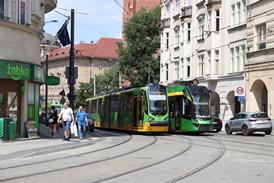Shortly to roll out of one of Plasser & Theurer’s Linz factories is the first AFKM automatic track control unit. Designed for use behind a ballast train, it integrates ballast ploughs, a ballast storage hopper and a dynamic stabiliser in a single machine. Plasser estimates that the AFKM will achieve the same performance in a single pass as an SSP110 ballast plough and DGS62N stabiliser, promising significant economies in terms of staff and shorter possessions.
Mounted at the front of the machine is a laser-operated device to measure the ballast profile. Using the radar principle, it sends out a laser pulse which is reflected back from the ballast. The time taken for the pulse to return to source allows the actual profile of the ballast to be measured. This is then compared with the specified profile, and the information is used to compute the precise requirements for profiling. These are then displayed to the machine operator controlling the ballast feed and ploughs.
A dynamic stabilisation unit is positioned immediately behind the set of ploughs, and any surplus ballast from the stabilisation process is swept up and moved by conveyor to a 10m3 storage hopper or disposed of to one side.
At the rear of the AFKM is a two-axle geometry and track dynamics checking car. This is able to monitor eight parameters, which can be displayed and stored on diskette. These include the track’s lateral resistance, which is measured as part of the dynamic track stabilisation process. o
CAPTION: The front of the unit (far right) measures the ballast profile, which is then modified to meet the specified profile by a set of ploughs, topped up with ballast from the storage hopper if needed. After stabilisation, surplus ballast is removed before final checking by the rear vehicle
CAPTION: The storage hopper can hold up to 10m3 of ballast




















